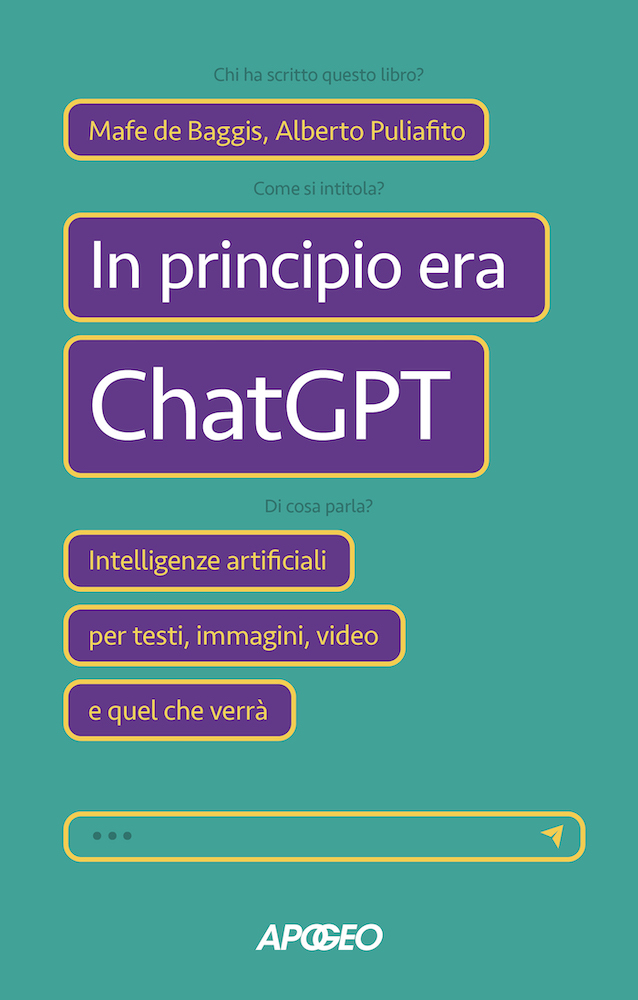We don’t know, dear readers, whether so far we have more technical articles on generative AI (those that explain, in short, how it works) or those that give an account of the varied range of emotions that is accompanying this tech revolution.
Effectively, generative artificial intelligence is likely to revolutionize our lives. From a social, working point of view, probably also linguistic, emotional and who knows what else.
And in the face of revolutionary events, extreme reactions – of fear or a priori enthusiasm – are both wrong. Because they are based on emotion, which by its very nature replaces the critical attitude.
Things, however, must first be known. So that (since they are there, and you can’t pretend that they aren’t there) you can make the most of them, rather than being overwhelmed by them.

In the beginning it was ChatGPT: the authors
In this spirit, and in the name of meritorious irony, Mafe de Baggis and Alberto Puliafito wrote In the beginning it was ChatGPT.
The book, released by Apogeo in September 2023, has the subtitle Artificial Intelligence for texts, images, videos and what is to come.
Mafe de Baggis is an advertiser, writer and digital media expert. She works as a communications consultant for small and large companies. While Alberto Puliafito is a journalist, director, producer, media analyst and director of Slow News.
Technology and the use made of it
In the Beginning Was ChatGPT is an interesting book especially for its perspective: the authors’ objective is in fact to show the groundlessness of the fears that invade the souls of the most doubtful readers towards generative AI.
And they do so already in the initial chapters, dedicated to the history of artificial intelligence. Where with a tasty chess anecdote it is explained how, for example, the interaction between man and machines has ancient roots, “and the alliance that we can establish with the technologies that we shape – and that shape us – is neither a utopia nor a dystopia. How we use them is up to us” (pp. 24-5).
But how does ChatGPT work?
Next we illustrate how ChatGPT works, or rather how it is trained. And how it learns semantic relationships: by proximity. But the more the amount of data provided to the machine grows (and the more refined the deep learning techniques become), the more generative AI will be able to establish unpredictable relationships.
On the other hand, our creativity is also more fruitful the more we are challenged, both in a quantitative and qualitative sense.
De Baggis and Puliafito are always ready to play on the sidelines between the innovations of artificial AI and everything that belongs to our nature, and to our culture before the arrival of OpenAI. To prove that Conversational chatbots and software that create images from texts are not dark entities descending on us from who knows where, but potential allies (if known and used properly).
The issue of copyright
The chapter dedicated to the so-called copyright is important, and not simple. Which is introduced by a courageous statement at the end of the previous chapter, the second. In fact, we read on p. 48 that if “we try to solve these problems with categories from the past – from copyright onwards -, it will be very difficult to democratize access to new machines”.
It therefore requires a great effort on our part. Let’s say it: a change of perspective. In short, in order for the potential of generative AI to be expressed in all its potential, we must abandon the rigid author-work duopoly, and think in more collaborative terms (it is about collectivization, it would have been said a few decades ago). Only in this way, however, will there be a democratic and non-exclusive – and non-classist, in short – use of AI.
Concept reiterated in the chapter on laws and regulations: there is no need for an excessive number of regulations, which would favor “those who already hold the oligopoly of the production of these machines” (p. 70). Rather, sensible rules are needed.
ChatGPT (and Midjourney) basically
And finally, the fifth chapter of In the Beginning Was ChatGPT explains not only what generative AI does, but also how to use it well. That is, how to become familiar with the text (ChatGPT) and image (Midjourney) generators.
We must first know the areas in which these machines can help us, and then the commands to be given so that their help is maximally effective.. Always remembering that if we need them, they need us, to be increasingly cultured, precise, effective, and reckless when necessary.
But also remembering something else, as suggestive as it is too often forgotten. We are witnesses of a new era: “what amazes us today will be ordinary in the future. We are like the first spectators who saw moving images in the cinema, like the first people who played Pong. Only now we can tell each other easily – even from a distance – and share it with whoever we want” (p. 105).















Leave a Reply
View Comments